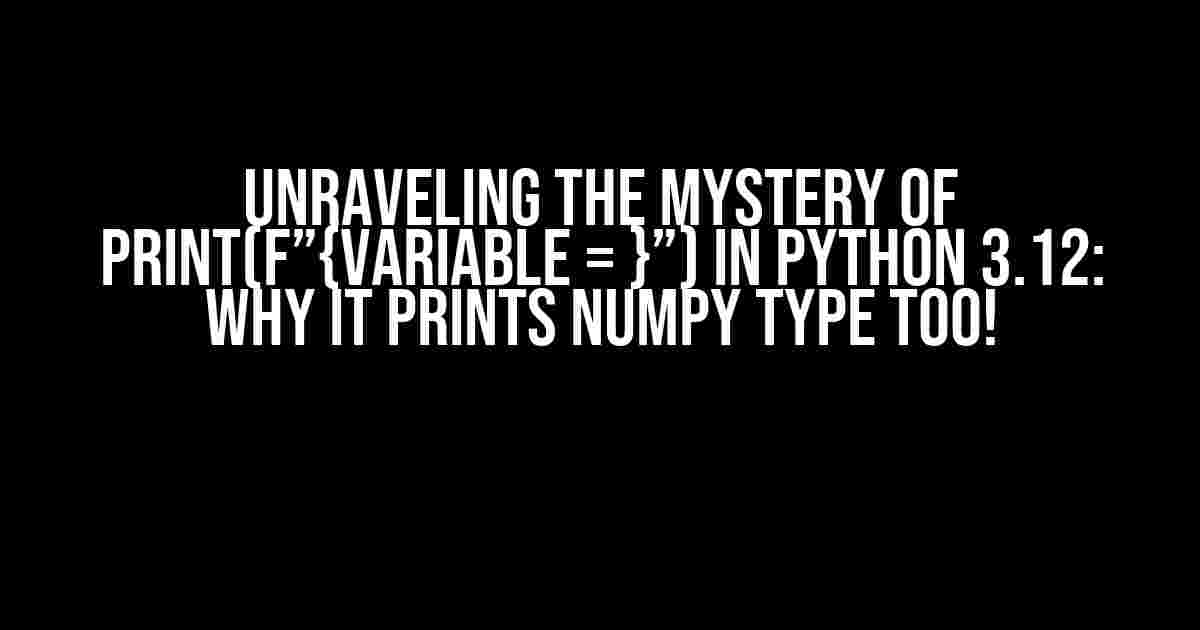Introduction
Python 3.12 has brought forth a plethora of exciting features and improvements, but one particular aspect has left many developers scratching their heads: the behavior of print(f”{variable = }”). In this article, we’ll delve into the mysteries of this syntax and explore why it prints not only the variable’s value but also its type, including numpy types.
The Syntax: A Quick Refresher
Before we dive into the why, let’s quickly refresh our memory on the syntax. In Python 3.12, you can use the following syntax to print a variable along with its name:
variable = 10
print(f"{variable = }")
This will output:
variable = 10
Simple, right? But, what happens when we introduce a numpy array into the mix?
The Numpy Twist
Let’s create a numpy array and see what happens:
import numpy as np
array = np.array([1, 2, 3])
print(f"{array = }")
To our surprise, the output is:
array = [1 2 3]
Wait, what? Why did it print the type of the array as well? That’s not what we asked for, did we?
What’s Going On Under the Hood?
To understand this behavior, we need to peek under the hood and see what Python is doing when we use this syntax. When you use `print(f”{variable = }”)`, Python is actually using the `__repr__` method of the variable to generate the string representation.
In the case of our numpy array, the `__repr__` method returns a string that includes the type information. This is because numpy arrays are objects, and their `__repr__` method is designed to provide a concise and informative representation of the object.
Diving Deeper: The `__repr__` Method
Let’s take a closer look at the `__repr__` method. In Python, every object has a `__repr__` method that returns a string representation of the object. By default, this method returns a string that includes the object’s type and its value.
For example:
class MyClass:
def __init__(self, value):
self.value = value
def __repr__(self):
return f"MyClass(value={self.value})"
obj = MyClass(10)
print(repr(obj)) # Output: MyClass(value=10)
In the case of numpy arrays, the `__repr__` method is overridden to provide a more informative representation. When we call `print(f”{array = }”)`, Python is essentially calling `print(f”{array.__repr__() = }”)`, which includes the type information.
But Why Does it Print the Type?
So, why does Python include the type information when printing the numpy array? The reason lies in the design philosophy of Python. Python is a dynamically-typed language, which means that the type of a variable is determined at runtime, not at compile time.
By including the type information, Python provides a way to convey the meaning and intent of the code. When you see the output `array = [1 2 3]`, you know that `array` is a numpy array, and you can make informed decisions about how to work with it.
Practical Implications
So, what does this mean for us as developers? Here are a few key takeaways:
- Be mindful of the `__repr__` method**: When working with custom objects, make sure to override the `__repr__` method to provide a meaningful representation of your object.
- Use the syntax wisely**: The `print(f”{variable = }”)` syntax can be a powerful tool for debugging and logging, but be aware of the implications of including type information.
- Leverage numpy’s custom representation**: Numpy arrays have a rich set of methods and attributes that can be used to customize their representation. Take advantage of these features to create informative and concise output.
Conclusion
The `print(f”{variable = }”)` syntax in Python 3.12 may seem mysterious at first, but once you understand the underlying mechanics, it becomes a powerful tool for working with variables and objects. By embracing the `__repr__` method and being mindful of type information, you can write more informative and effective code.
So, the next time you encounter this syntax, remember that it’s not just printing the value – it’s telling a story about the variable itself.
| Variable | Output |
|---|---|
| Integer | variable = 10 |
| Numpy Array | array = [1 2 3] |
| Custom Object | obj = MyClass(value=10) |
By understanding the nuances of this syntax, you’ll be better equipped to tackle complex problems and write more effective, Pythonic code. Happy coding!
Frequently Asked Question
Get ready to uncover the mystery behind Python 3.12’s quirky behavior!
Q1: Why does print(f”{variable = }”) in Python 3.12 also print the numpy type?
The reason behind this phenomenon is that Python 3.12’s f-strings have been upgraded to include the type of the variable being printed. This means that when you use the syntax `print(f”{variable = }”)`, Python will automatically include the type of the variable in the output, which is why you’re seeing the numpy type being printed along with the variable’s value.
Q2: Is this behavior specific to numpy variables only?
No way, José! This behavior is not limited to numpy variables only. In fact, Python 3.12’s f-strings will include the type of any variable being printed, whether it’s a string, integer, float, or any other data type.
Q3: Can I disable this behavior and only print the variable’s value?
You bet! If you want to print only the variable’s value without the type, you can simply remove the `=` symbol from the f-string syntax. For example, `print(f”{variable}”)` will only print the variable’s value, without including the type.
Q4: Is this behavior a bug or a feature?
This behavior is actually a deliberate design choice made by the Python developers to provide more informative output when using f-strings. So, it’s a feature, not a bug!
Q5: Are there any other cool features like this in Python 3.12?
Oh, yeah! Python 3.12 is packed with awesome features, like improved error messages, enhanced f-strings, and more. Be sure to check out the official Python documentation to discover all the new goodies!
